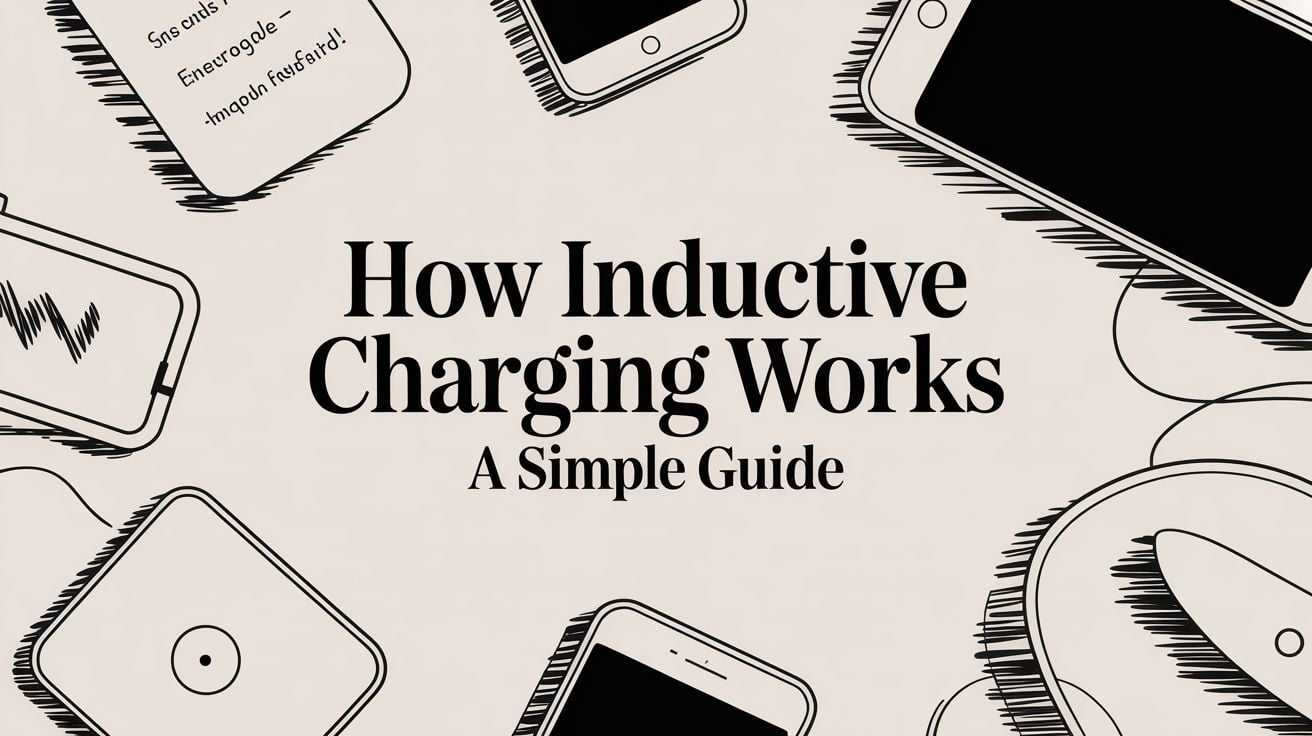
How Inductive Charging Works: A Simple Guide
Placing your phone on a charging pad and watching it power up without any cables still feels a bit like magic, doesn't it? The science behind it, though, is surprisingly simple. It all comes down to creating a short-range magnetic field between a transmitter (the charging pad) and a receiver (your phone). This magnetic field creates a real electrical current inside your phone, which then charges the battery—no plugs needed.
The Invisible Cord Powering Your Devices
Ever wondered how your phone’s battery gets a refill just by resting on a surface? The secret is a cool principle of physics that acts like an invisible power cord. Instead of a physical wire carrying electricity, wireless chargers "send" energy through the air for a very short distance.
This process is called electromagnetic induction, and it's the heart of how wireless charging works. It’s all about turning electricity into a magnetic field and then, moments later, turning it back into electricity again. Think of it like two musicians with tuning forks; when one vibrates, the sound waves cause the other nearby fork to start vibrating at the same frequency. In the same way, a coil in the charging pad creates a magnetic "vibration," and a matching coil in your phone picks it up.
From Magnetism to Battery Power
The whole system depends on two key parts working together. This teamwork is what makes the seamless power transfer possible, and understanding their roles is the first step to seeing past the "magic."
Let's break down the essential players in this process. It's a simple, elegant dance between two main components.
Wireless Charging Quick Breakdown
Here's a simplified look at the key components and what they do in the wireless charging process.
| Component | Simple Analogy | What It Does |
|---|---|---|
| Transmitter Coil | A speaker | Located in the charging pad, it takes power from the wall and "sends" it as a magnetic field. |
| Receiver Coil | A microphone | Tucked inside your device, this coil is designed to "hear" or "catch" that magnetic field. |
| Power Transfer | Sound to signal | When the magnetic field hits the receiver coil, it creates an electrical current that charges the battery. |
This quick look shows just how logically the system works, with each part playing a crucial role in delivering power without a single wire.
This whole concept isn't a new invention. The principles of wireless power have been around since the late 19th century. Early experiments by Nikola Tesla with his famous Tesla coil proved that energy could be sent wirelessly, laying the groundwork for the tech we use every day.
A Long History of Innovation
The idea of sending power through the air has fascinated inventors for over a century. The basic science of turning electricity into a magnetic field and back again dates all the way back to pioneers like Nikola Tesla. To really appreciate how far we've come, it's worth exploring the historical timeline of wireless power to see how those early ideas evolved.
Today, what was once a futuristic dream is a common feature in everything from our smartphones and smartwatches to electric toothbrushes and even electric cars. It’s a perfect example of how a brilliant scientific principle can become an integral part of our daily lives, making technology just that little bit more convenient.
Understanding Electromagnetic Induction
At the heart of every wireless charger is a fascinating bit of physics called electromagnetic induction. It might sound complicated, but the concept is actually pretty simple. Think of electricity and magnetism as best friends—when one is around, the other isn't far behind.
Whenever electricity zips through a wire, it creates an invisible magnetic field around it. You can't see it, but it's there. Inductive charging cleverly uses this relationship by creating a constantly pulsing magnetic field inside the charging pad.
And that’s where the real magic happens. Just like a magnet moving past a wire can create electricity, that pulsing magnetic field from your charger reaches out and starts a "conversation" with a similar wire coil inside your phone.
Creating an Electrical Current from a Magnetic Field
Ever dropped a pebble into a calm pond? You get those ripples that spread out from the center. If a little leaf is floating nearby, those ripples make it bob up and down.
Electromagnetic induction is a lot like that:
- The Charging Pad is the Pebble: It creates the invisible, pulsing magnetic field—the "ripples."
- Your Phone is the Leaf: It has a receiver coil inside, just "floating" in that field.
- The Ripples Create Movement: As the magnetic field pulses, it shoves tiny particles called electrons around inside your phone's receiver coil, forcing them to move.
And that controlled movement of electrons? That's electricity. By getting those electrons moving, the charging pad sends power to your device without ever touching it. It’s an incredibly neat trick that works best over super short distances, which is why your phone has to sit right on the pad.
Key Takeaway: Inductive charging doesn't "beam" electricity through the air. Instead, it uses a magnetic field as a bridge to kickstart the flow of electricity inside your device's own wiring.
This handy map shows you the whole journey, from the wall outlet all the way to your phone's battery.
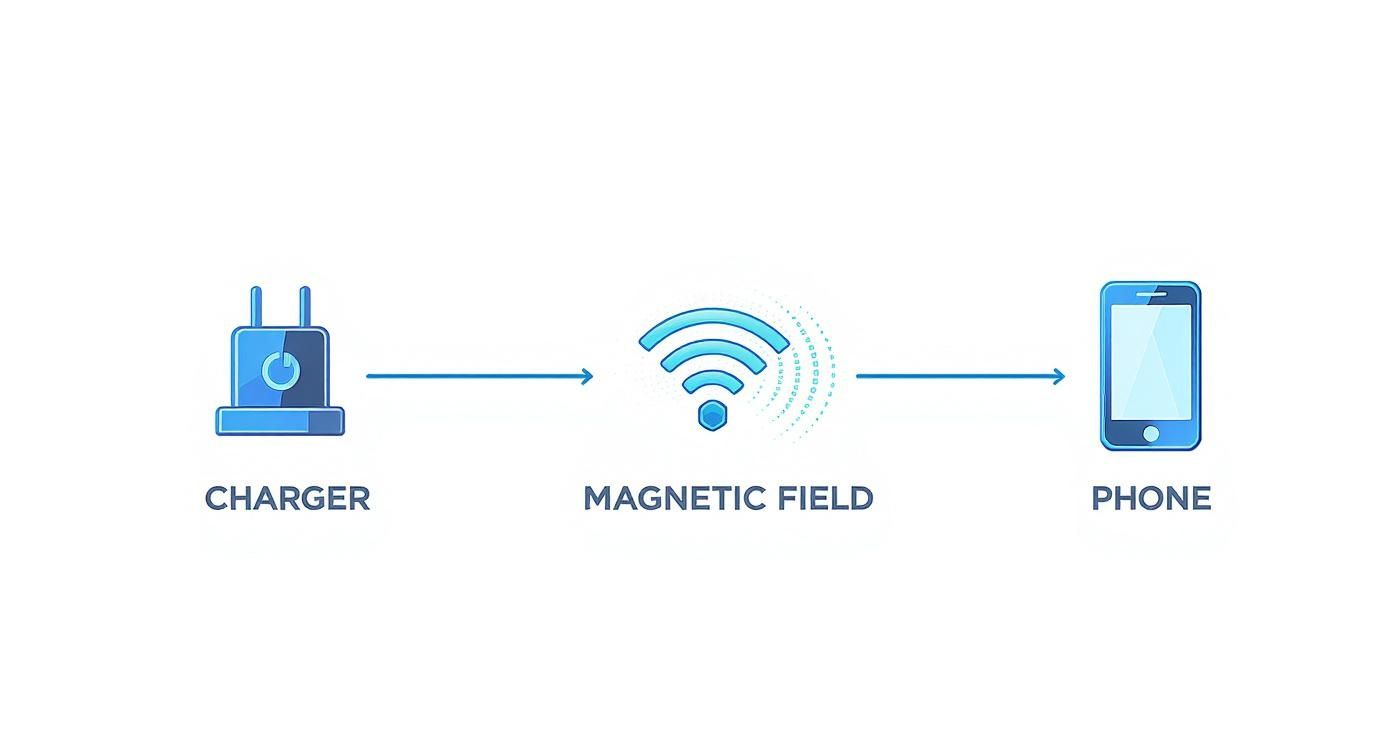
You can see how the charger takes power from the wall, turns it into a magnetic field, and that field then gets the electricity flowing in the phone to fill up the battery. A perfect wireless hand-off.
The Importance of Alternating Current
Now, for this whole process to work, the electricity flowing into the charging pad can't be a steady, one-way street. It has to constantly switch directions. This is called alternating current (AC), and it’s the same stuff that comes out of your wall sockets.
If you used a steady, unchanging direct current (DC), you’d just get a boring, static magnetic field. It would just sit there, not doing anything. It’s the constant change—the magnetic field growing, shrinking, and flipping direction—that keeps the electrons in your phone's coil dancing and generating power.
This whole idea goes way back to Michael Faraday in the 1830s. It's a fundamental law of physics that’s been turned into one of the most convenient bits of tech we use every day. Now that we've got the core concept down, let's look at the hardware that makes it all tick: the coils.
Meet the Key Players: The Coils
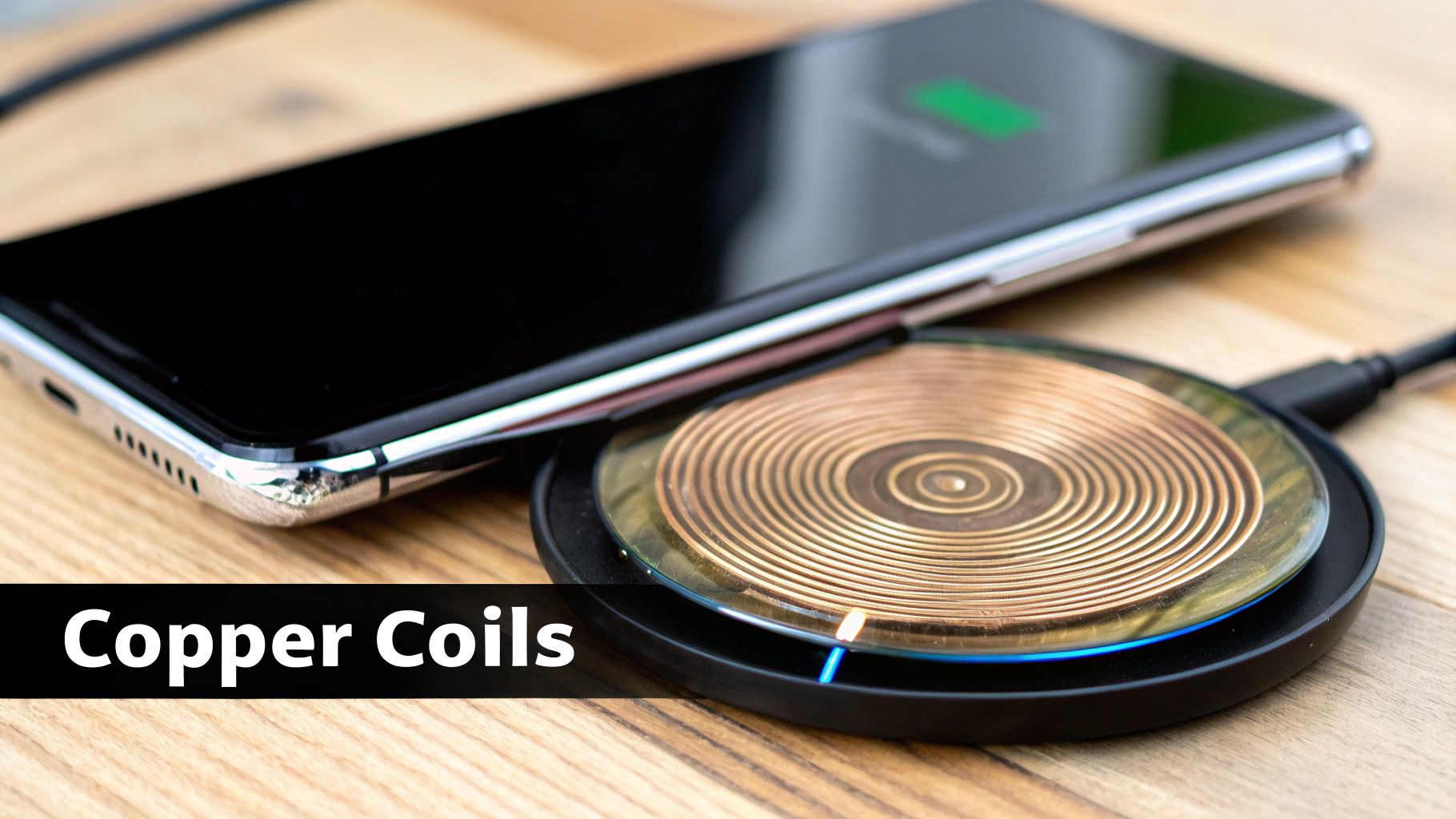
Alright, we've got the theory of electromagnetic induction down. Now, let's meet the two pieces of hardware that do all the heavy lifting. Every single wireless charging system you've ever seen boils down to a pair of coils: a transmitter coil tucked inside the charging pad and a receiver coil living inside your phone or gadget.
The easiest way to think about them is like a pitcher and a catcher in a baseball game. The transmitter coil in the pad is the pitcher, winding up to "throw" energy by creating a magnetic field. On the other end, the receiver coil in your phone is the catcher, perfectly positioned to "catch" that energy and turn it back into electricity for your battery.
This simple partnership is the heart of inductive charging. The design, material, and even the shape of these coils decide everything from how fast your phone charges to how much energy is wasted as heat.
The Transmitter Coil: The Pitcher
The transmitter coil is hooked up to a power source—your wall outlet—and its entire job is to create that pulsing magnetic field. When you plug it in, electricity flows through the coil, generating the magnetic energy that kicks off the whole process. It’s the active part of the duo, constantly ready to send power.
Look closely, and you'll see these coils are almost always made of tightly wound copper wire. There's a good reason for that: copper is an amazing conductor. It lets electricity flow freely with very little resistance, which is critical for creating a strong magnetic field without losing a bunch of energy as heat.
The shape and size are also carefully designed. A larger coil, for example, can generate a bigger magnetic field, which can give you a little more wiggle room when you place your device on the pad.
The Receiver Coil: The Catcher
Hiding inside your phone, smartwatch, or earbuds is the receiver coil. This one is passive; it just sits there until it enters the magnetic field from the transmitter. Once it's in range, that pulsing field gets the electrons moving in the receiver's copper wiring, creating an electric current.
That freshly created electricity gets sent over to your device's battery charging circuit, and you see your battery percentage start to climb. The receiver coil is basically a tiny antenna, tuned to perfectly pick up the magnetic "frequency" being broadcast by the pad.
Just like its transmitter buddy, the receiver coil's design is vital. Engineers have to strike a delicate balance between making it small enough to fit inside a sleek phone and powerful enough to capture energy efficiently.
The secret to how inductive charging works is the relationship between these two coils. The power transfer drops off a cliff with distance. This is exactly why your phone needs to be practically touching the charging pad to work.
But the conversation isn't just one-way. Modern chargers, especially those following the Qi standard, allow the receiver coil to talk back to the transmitter. This lets your phone send little messages to the charger, like:
- "Hey, my battery is full. You can stop sending power now."
- "I'm getting a bit warm over here, can you dial back the power?"
- "Warning! There's a coin or key on the pad. Shut down for safety."
This constant chatter makes the whole process smarter, safer, and better for your battery's long-term health.
Why Alignment is So Important
The "pitcher and catcher" analogy also perfectly explains why alignment is king. To get the best possible power transfer, the two coils need to be lined up almost perfectly. Think about it: if the catcher drifts too far to one side, they're going to miss the ball.
When the coils are misaligned, the receiver can only "catch" a weak, partial version of the magnetic field. This leads to a few problems:
- Slower Charging: Less energy is being transferred, so your battery juices up at a snail's pace.
- More Heat: All that wasted energy has to go somewhere, and it usually turns into excess heat, which is a battery's worst enemy.
- No Charging at All: If the coils are too far out of alignment, the connection can fail completely.
This is precisely why many modern chargers—like Apple's MagSafe or anything using the new Qi2 standard—have magnets built-in. They automatically snap your phone into the sweet spot, guaranteeing the coils are perfectly aligned every single time for the fastest, most efficient charge.
How Wireless Charging Became a Reality
The wireless charging we rely on today didn't just appear out of thin air. It was a long journey, moving from a niche scientific curiosity to the reliable, everyday tech we now take for granted. Its story doesn't start with smartphones, but in specialized fields where tangled wires were impractical, unsafe, or flat-out impossible.
Long before charging pads showed up on our desks, inductive charging was quietly proving its worth in some really critical spots. Take your electric toothbrush, for instance. Keeping it waterproof is a must for safety, and a traditional charging port would be a perfect entry point for moisture. Wireless charging solved this beautifully, letting the toothbrush stay completely sealed while still being a breeze to recharge.
It was the same story for early medical devices like pacemakers. A wired connection for an implant inside the body? That’s a total non-starter due to the huge risk of infection. Inductive charging provided a safe, sterile way to power these life-saving devices right through the skin, proving just how reliable it could be in the most demanding situations.
The Journey to Your Pocket
For decades, inductive charging was a clever solution for a handful of specific problems. The real hurdle was getting it into the wider world of consumer electronics. Early versions were slow and wasted a lot of energy, and to make matters worse, every brand had its own system. A Nokia charger was useless for a Samsung phone, creating a mess of confusion and frustration for everyone.
This fragmentation was a massive roadblock. For wireless charging to ever become mainstream, it needed a universal language that all devices could speak.
The real turning point came when the industry rallied around a single, unified standard. Without this cooperation, wireless charging would have likely remained a novelty, and we wouldn't have the simple "drop-and-charge" convenience we enjoy today.
The creation of the Qi (pronounced "chee") standard was the big breakthrough. This universal set of rules finally let different manufacturers build devices and chargers that could all work together, no questions asked.
The Rise of a Universal Standard
The road to today's wireless charging had several key milestones. For example, a wireless charging system was created for General Motors' EV1 electric car way back in the late 1990s, hinting at its potential for bigger things. But it was the Qi standard, introduced in 2011, that truly opened the floodgates for consumer gadgets and has been the global benchmark ever since. You can get a great detailed overview on the evolution of wireless charging that covers this whole journey.
With a common standard locked in, innovation kicked into high gear. Engineers could finally focus on fixing the technology's early growing pains:
- Charging Speed: Let's be honest, early wireless chargers were painfully slow. But constant tweaks to coil design and power management have cranked up the speeds to a point where they can rival many wired chargers.
- Efficiency: A lot of energy used to get wasted as heat in those first-generation pads. Modern systems are way smarter, transferring more power directly to the battery where it belongs.
- Alignment Issues: Getting your phone in that perfect sweet spot used to be a finicky dance. The introduction of magnets, made popular by systems like MagSafe and the new Qi2 standard, nailed this problem by snapping devices into the optimal position every single time.
This history shows that the tech behind inductive charging isn't some new fad—it's a well-established science that's been refined over many years. It’s a huge leap in how we transfer power, and you can also dive into other energy innovations that are shaping our future.
Why Some Wireless Chargers Are Faster Than Others
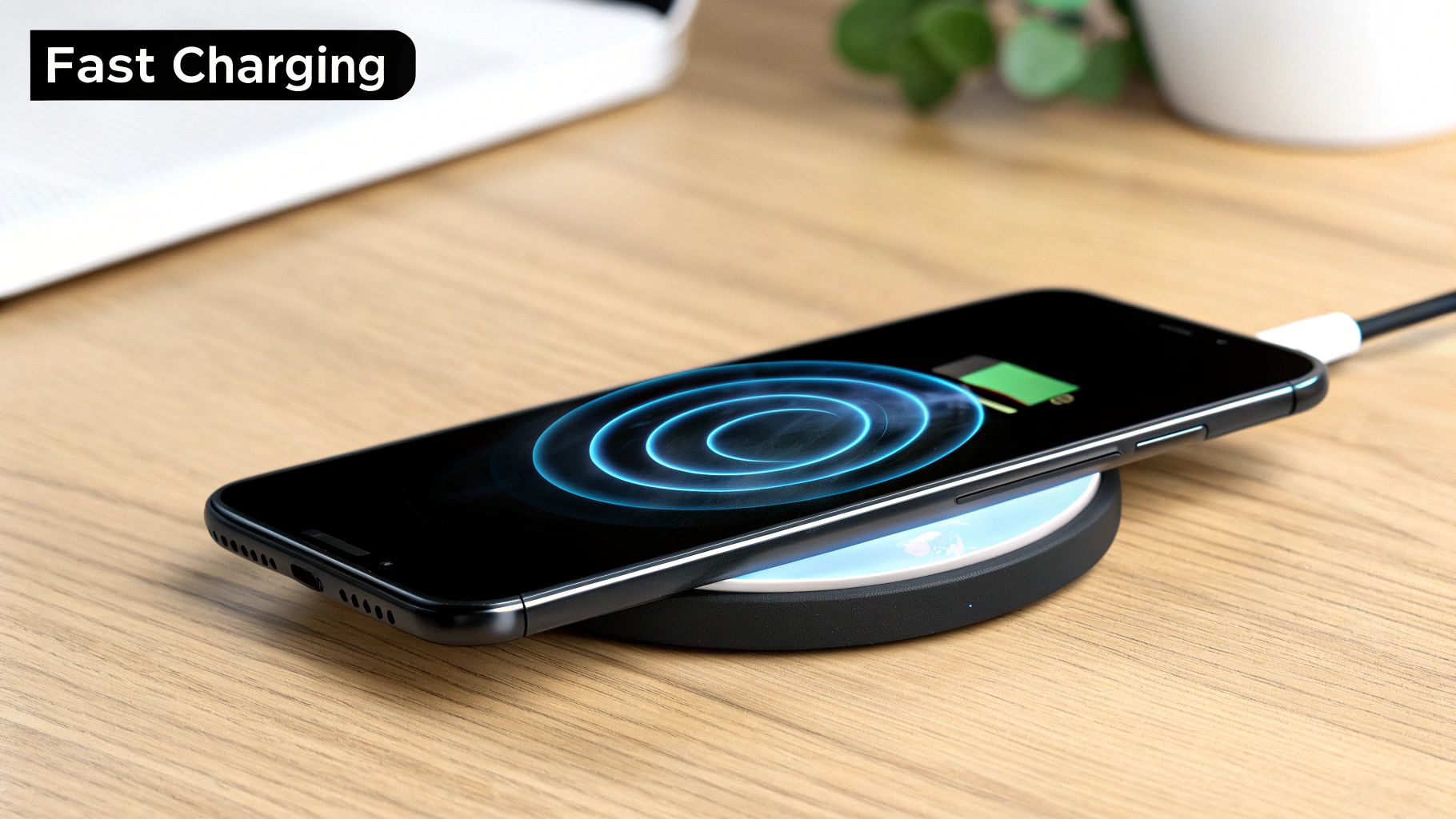
You’ve probably noticed it yourself—some wireless chargers juice up your phone in what feels like minutes, while others seem to take all night. This isn't just in your head. There's a real difference in speed, and it comes down to a few key factors, from the tech inside the pad to some simple physics.
The biggest variable is the charger's power output, measured in watts (W). A basic charger might only push out 5W of power. Faster models can easily deliver 10W, 15W, or even more. Think of it like a hose filling a bucket; higher wattage is like a wider hose, letting more energy flow at once.
Of course, it's a two-way street. Your phone also has to be capable of handling that extra power. A beefy 15W charger won't do you any good if your phone is only designed to accept 5W wirelessly. The two devices actually talk to each other to agree on the fastest, safest charging speed they can both handle.
The Power of Resonance
Beyond just raw wattage, there's a smarter technology at play in modern chargers called resonant charging. This is what makes the whole process more forgiving and efficient, especially when you don't place your phone on the pad perfectly.
Imagine two opera singers. If they both hit the exact same note, the sound waves amplify each other and become much more powerful. Resonant charging is the electrical version of that. The coils in the charger and your phone are "tuned" to the same frequency, creating a strong, stable magnetic link that transfers power much more effectively, even with a small gap or slight misalignment.
This tuning creates a more efficient "handshake" between the charger and your device. It cuts down on wasted energy and keeps the charge steady, which is key for hitting those top speeds without cooking your phone.
Thanks to breakthroughs like this, inductive charging has come a long way. Early versions were frustratingly slow and picky about placement, but better coil designs and resonant charging have changed the game. Today's top-tier wireless pads can rival many wired chargers, with some devices now supporting speeds of 15W or more.
Common Roadblocks to a Fast Charge
Even with the best tech, a few real-world obstacles can slow your charge to a crawl. Knowing what they are is the first step to getting the speed you paid for.
- Thick Phone Cases: Most chargers are designed to work through cases up to 3-5mm thick. But if you're using a super-rugged, "armor-style" case, that extra bulk can weaken the magnetic field and drag down your charging speed.
- Metal and Magnets: Metal is the sworn enemy of wireless charging. Any metal plates for car mounts, pop sockets with metal components, or even credit cards can block the magnetic field entirely. This will either stop the charge or trigger the charger's safety features to shut it down.
- Poor Alignment: As we talked about, the coils have to line up. If your phone is sitting off-center on the pad, the connection gets weak. This leads to painfully slow charging and generates a lot of extra heat.
Heat: The Silent Speed Killer
One of the most important jobs for any charger is managing heat. Transferring energy through the air naturally generates some warmth, but too much of it is incredibly bad for your phone's battery. High temperatures can cause permanent damage to a battery's internal parts, shortening its overall lifespan.
To prevent a meltdown, both your phone and the charger are packed with temperature sensors. If things start getting too toasty, the system automatically slows down the charging speed to let things cool down. It’s a critical safety feature that protects your expensive hardware. You can learn more about the impact of temperature on battery degradation to see just how important this is.
The principles of battery health and charging efficiency are surprisingly universal. To see how these same ideas apply on a much larger scale, it's worth reading about EV fast charging and the 80% rule, as many of the core concepts about battery care carry over.
Inductive Charging in Everyday Life
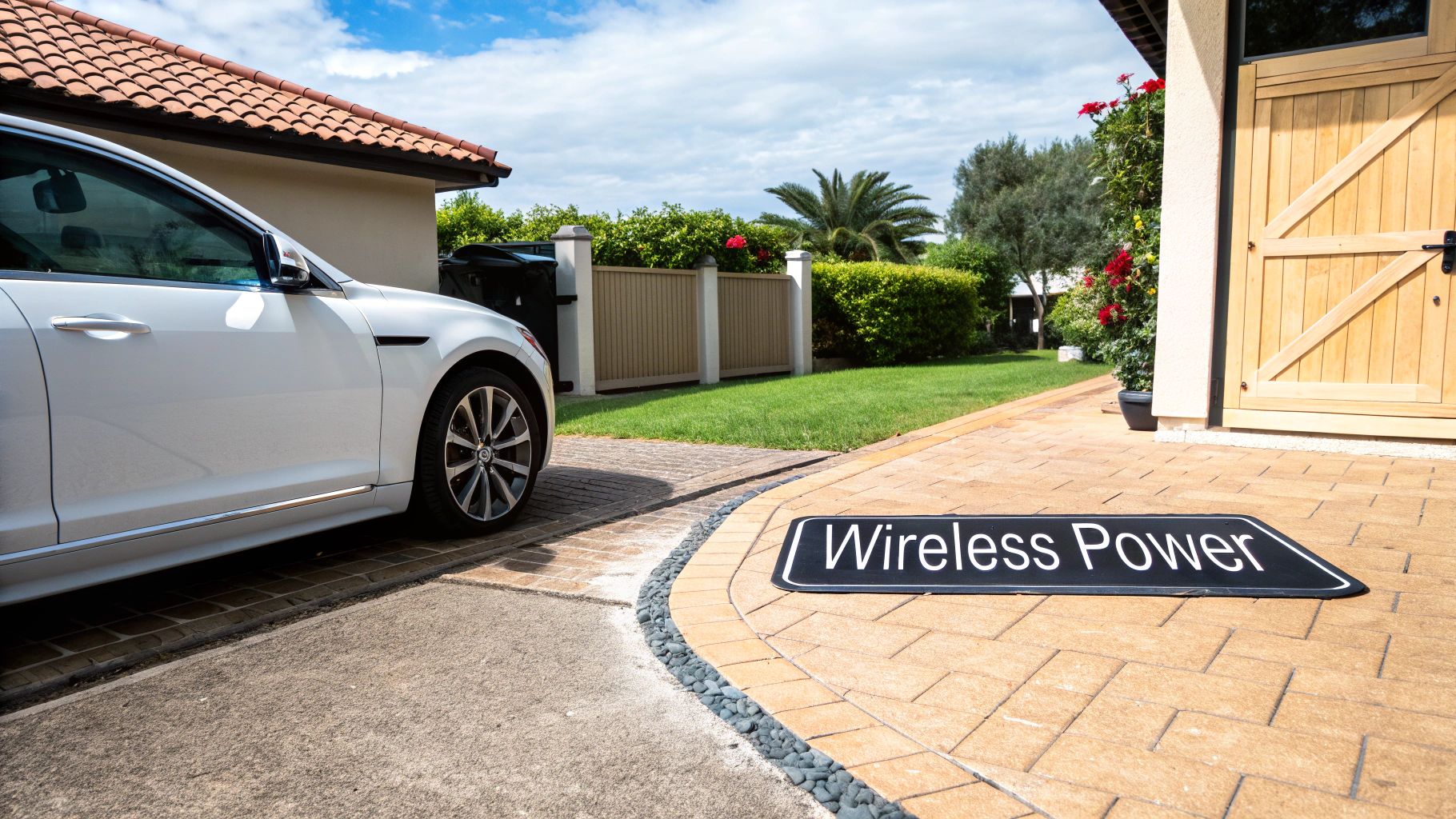
When you hear "wireless charging," your mind probably jumps straight to your smartphone. And fair enough. But this clever bit of tech is working its magic in a lot more places than you might realize.
The ability to send power through the air, even over a short distance, is a genuine game-changer. It’s not just about convenience; it’s about making our gadgets safer, tougher, and more reliable by getting rid of the weakest link: the charging port.
Powering a Waterproof World
Think about your electric toothbrush or shaver. These things live in the bathroom, surrounded by water. A traditional charging port would be a disaster waiting to happen—a perfect entry point for moisture, leading to rust and electrical hazards.
Inductive charging neatly solves this. By sealing the electronics inside a completely waterproof plastic shell, manufacturers can create devices that are practically immune to water damage. The power simply passes from the coil in the base to the coil in the handle. It’s a simple, elegant solution that dramatically extends the life and safety of these everyday items.
Inductive charging is more than a convenience; it's a key technology. It allows engineers to design products that are fundamentally safer and more durable by eliminating the weaknesses of physical connectors.
From Medical Miracles to Electric Vehicles
The real magic of inductive charging becomes clear when you see where else it's being used. It’s popping up in critical, large-scale applications where cables are not just inconvenient but downright impossible.
Take a look at where this technology is making a real difference:
| Application | Primary Benefit | Example |
|---|---|---|
| Medical Implants | Safety & Sterility | Pacemakers can be recharged right through the skin, eliminating infection risks and the need for surgery. |
| Electric Vehicles (EVs) | Convenience & Automation | Parking your car over a charging pad in the garage means no more wrestling with heavy, dirty cables. |
| Industrial Automation | Efficiency | Robotic vehicles in warehouses can automatically top up their batteries at charging stations, allowing for 24/7 operation without human help. |
As you can see, a simple magnetic field is redefining what’s possible in fields as different as healthcare and transportation.
Of course, with all these devices, managing how they charge is the key to making them last. For your phone, understanding the relationship between Chargie and wireless chargers is crucial for protecting your battery's health in the long run. What started as a novelty is now a core piece of modern engineering.
Got Questions About Wireless Charging?
Once you start using wireless charging, a few practical questions always seem to pop up. Getting a handle on these common concerns will help you make the most of your chargers and keep your phone’s battery in top shape for the long haul.
Is This Stuff Safe for Me and My Phone?
Yes, it’s completely safe. Wireless chargers use a very low-power magnetic field that only travels a tiny distance from the pad. Think of it as a harmless energy bubble that poses zero risk to people or pets.
As for your phone, modern chargers are loaded with safety features. They have built-in temperature sensors to stop things from getting too warm and can even detect foreign objects. If you accidentally leave keys or coins on the pad, the charger is smart enough to cut the power so nothing overheats. These protections keep your device and its battery safe and sound.
Is Wireless Charging a Lot Less Efficient Than a Cable?
It’s a little less efficient, but the difference is smaller than you might think. A bit of energy—usually around 20-30%—gets lost as heat when power is transferred through the air.
But technology has come a long way. Today’s fast wireless chargers can juice up your phone at speeds that easily match, and sometimes even beat, standard wall chargers. For most of us, the sheer convenience is well worth that small trade-off in efficiency.
Key Takeaway: A cable is technically the most efficient way to charge, but the grab-and-go convenience of wireless charging easily outweighs the minor energy loss.
Will My Phone Case Get in the Way?
Probably not! Wireless chargers are built to work right through most standard plastic, silicone, or rubber cases up to 5mm thick. You can just set your phone down and let it charge, no fiddling with the case required.
The only real exceptions are cases with metal in them, like those with built-in kickstands or magnetic plates for car mounts. Metal messes with the magnetic field and will block the charge. Super-thick, rugged "armor" style cases can also cause problems sometimes.
Can I Just Leave My Phone on the Charger Overnight?
Absolutely. Your phone and any certified wireless charger are designed to talk to each other to prevent overcharging. As soon as your battery hits 100%, the charger knows to stop sending power or will switch to a tiny trickle charge to keep it topped off. This is perfectly safe for your battery's long-term health.
If you want to take it a step further, you can learn about why slow charging is essential for your smartphone's battery health and see how managing those charge cycles can make a huge difference.
To take full control of your battery's health and extend its lifespan, explore how Chargie can help you implement smarter charging habits automatically. Learn more at https://chargie.org.

